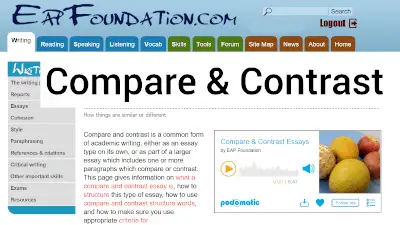Show AWL words on this page.
Show sorted lists of these words.


 







|
 Podcast is loading. Problems? Too slow? You can also access the Podcast by
clicking here.
Podcast is loading. Problems? Too slow? You can also access the Podcast by
clicking here.This message will disappear when then podcast has fully loaded.
Compare and contrast is a common form of academic writing, either as an essay type on its own, or as part of a larger essay which includes one or more paragraphs which compare or contrast. This page gives information on what a compare and contrast essay is, how to structure this type of essay, how to use compare and contrast structure words, and how to make sure you use appropriate criteria for comparison/contrast. There is also an example compare and contrast essay on the topic of communication technology, as well as some exercises to help you practice this area.
What are compare & contrast essays?
To compare is to examine how things are similar, while to contrast is to see how they differ. A compare and contrast essay therefore looks at the similarities of two or more objects, and the differences. This essay type is common at university, where lecturers frequently test your understanding by asking you to compare and contrast two theories, two methods, two historical periods, two characters in a novel, etc. Sometimes the whole essay will compare and contrast, though sometimes the comparison or contrast may be only part of the essay. It is also possible, especially for short exam essays, that only the similarities or the differences, not both, will be discussed. See the examples below.
- Compare and contrast Newton's ideas of gravity with those proposed by Einstein ['compare and contrast' essay]
- Examine how the economies of Spain and China are similar ['compare' only essay]
- Explain the differences between Achaemenid Empire and Parthian Empire ['contrast' only essay]
Structure
There are two main ways to structure a compare and contrast essay, namely using a block or a point-by-point structure. For the block structure, all of the information about one of the objects being compared/contrasted is given first, and all of the information about the other object is listed afterwards. This type of structure is similar to the block structure used for cause and effect and problem-solution essays. For the point-by-point structure, each similarity (or difference) for one object is followed immediately by the similarity (or difference) for the other. Both types of structure have their merits. The former is easier to write, while the latter is generally clearer as it ensures that the similarities/differences are more explicit.
The two types of structure, block and point-by-point, are shown in the diagram below.
|
Block
Introduction
Object 1 - Point 1
Object 1 - Point 2
Object 1 - Point 3
Transition sentence/paragraph
Object 2 - Point 1
Object 2 - Point 2
Object 2 - Point 3
Conclusion
|
|
Point-by-point
Introduction
Point 1
Object 1 ➤ Object 2 Point 2
Object 1 ➤ Object 2 Point 3
Object 1 ➤ Object 2 Conclusion
|
Compare and Contrast Structure Words
Compare and contrast structure words are transition signals which show the similarities or differences. Below are some common examples.
Compare
- Similarly
- Likewise
- also
- both... and...
- not only... but also...
- neither... nor...
- just like (+ noun)
- similar to (+ noun)
- to be similar (to)
- to be the same as
- to be alike
- to compare (to/with)
Examples
- Computers can be used to communicate easily, for example via email. Similarly/Likewise, the mobile phone is a convenient tool for communication.
- Both computers and mobile phones can be used to communicate easily with other people.
- Just like the computer, the mobile phone can be used to communicate easily with other people.
- The computer is similar to the mobile phone in the way it can be used for easy communication.
Contrast
- However
- In contrast
- In comparison
- By comparison
- On the other hand
- while
- whereas
- but
- to differ from
- to be different (from)
- to be dissimilar to
- to be unlike
Examples
- Computers, although increasingly small, are not always easy to carry from one place to another. However, the mobile phone can be carried with ease.
- Computers are generally not very portable, whereas the mobile phone is.
- Computers differ from mobile phones in their lack of portability.
- Computers are unlike mobile phones in their lack of portability.
Criteria for comparison/contrast
When making comparisons or contrasts, it is important to be clear what criteria you are using. Study the following example, which contrasts two people. Here the criteria are unclear.
- Aaron is tall and strong. In contrast, Bruce is handsome and very intelligent.
Although this sentence has a contrast transition, the criteria for contrasting are not the same. The criteria used for Aaron are height (tall) and strength (strong). We would expect similar criteria to be used for Bruce (maybe he is short and weak), but instead we have new criteria, namely appearance (handsome) and intelligence (intelligent). This is a common mistake for students when writing this type of paragraph or essay. Compare the following, which has much clearer criteria (contrast structure words shown in bold).
- Aaron and Bruce differ in four ways. The first difference is height. Aaron is tall, while Bruce is short. A second difference is strength. Aaron is strong. In contrast, Bruce is weak. A third difference is appearance. Aaron, who is average looking, differs from Bruce, who is handsome. The final difference is intelligence. Aaron is of average intelligence. Bruce, on the other hand, is very intelligent.
Example essay
Below is a compare and contrast essay. This essay uses the point-by-point structure. Click on the different areas (in the shaded boxes to the right) to highlight the different structural aspects in this essay, i.e. similarities, differences, and structure words. This will highlight not simply the paragraphs, but also the thesis statement and summary, as these repeat the comparisons and contrasts contained in the main body.
Title: There have been many advances in technology over the past fifty years. These have revolutionised the way we communicate with people who are far away. Compare and contrast methods of communication used today with those which were used in the past.
Compare |
Contrast |
|||||
1 |
2 |
|||||
Compare transitions |
Contrast transitions |
|||||
Before the advent of computers and modern technology, people communicating over long distances used traditional means
such as letters and the telephone. Nowadays we have a vast array of communication tools which can complete this task,
ranging from email to instant messaging and video calls. While the present and previous means of communication
are similar in their general form, they
differ in regard to their
speed and the
range of tools available.
One similarity between current and previous methods of communication relates to the form of communication.
In the past, both written forms such as letters were frequently used, in addition to oral forms such as telephone calls.
Similarly, people nowadays use both of these forms.
Just as in the past, written forms of communication are prevalent, for example via email and text messaging. In addition,
oral forms are still used, including the telephone, mobile phone, and voice messages via instant messaging services.
However, there are clearly many differences in the way we communicate over long distances,
the most notable of which is speed. This is most evident
in relation to written forms of communication. In the past, letters would take days to arrive at their destination.
In contrast, an email arrives almost instantaneously and can be read seconds after it was sent.
In the past, if it was necessary to send a short
message, for example at work, a memo could be passed around the office, which would take some time to circulate.
This is different from the current situation, in which a text message can be sent immediately.
Another significant difference is the range of communication methods.
Fifty years ago, the tools available for communicating
over long distances were primarily the telephone and the letter.
By comparison, there are a vast array of communication
methods available today. These include not only the telephone, letter, email and text messages already mentioned,
but also video conferences via software such as Skype or mobile phone apps such as WeChat, and social media such as Facebook and
Twitter.
In conclusion, methods of communication have greatly advanced over the past fifty years. While there are some similarities,
such as the forms of communication, there are significant differences,
chiefly in relation to the speed of communication
and the range of communication tools available.
There is no doubt that technology will continue to progress in future,
and the advanced tools which we use today may one day also become outdated.
Compare |
||||
Contrast |
||||
1 |
2 |
|||
Compare transitions |
||||
Contrast transitions |
||||
Checklist
Below is a checklist for compare and contrast essays. Use it to check your own writing, or get a peer (another student) to help you.
| Item | OK? | Comment |
| The essay is a comparison and contrast essay | ||
| An appropriate structure is used, either block or point-by-point | ||
| Compare and contrast structure words are used accurately | ||
| The criteria for comparison/contrast are clear | ||
| The essay has clear thesis statement | ||
| Each paragraph has a clear topic sentence | ||
| The essay has strong support (facts, reasons, examples, etc.) | ||
| The conclusion includes a summary of the main points |
Resources
There is a downloadable graphic organiser for brainstorming ideas for compare and contrast essays in the writing resources section.
Next section
Find out how to write cause & effect essays in the next section.
Previous section
Go back to the previous section about persuasion essays.
You need to login to view the exercises. If you do not already have an account, you can register for free.







